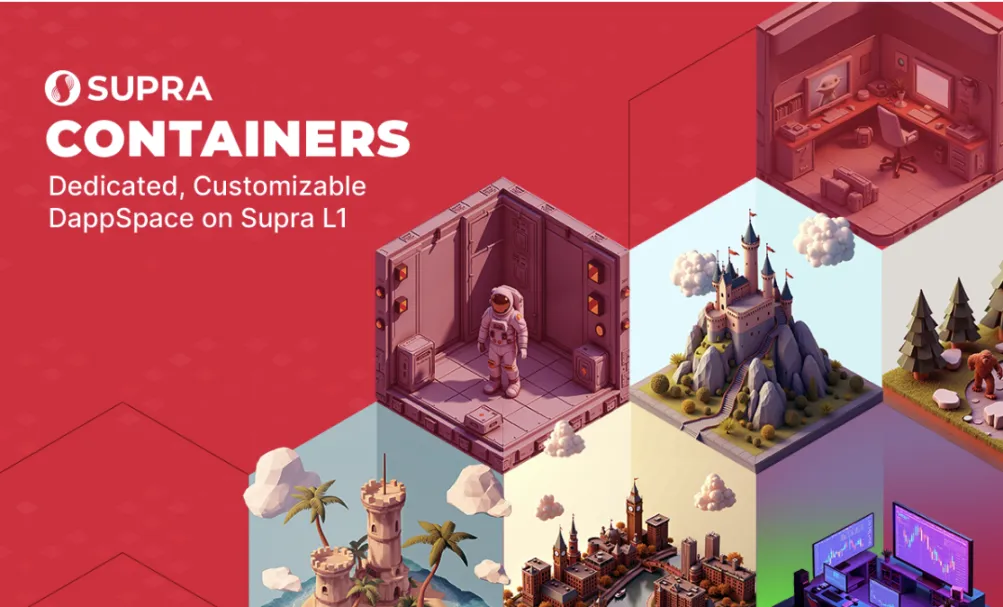Supra Releases New Product Containers, Will the era of L2 end?

Supra, a high-performance Layer 1 blockchain supporting 500,000 transactions per second (TPS) and Multi-VM, has officially launched its groundbreaking new product—Supra Containers. This innovative technology may eliminate the need for Layer 2 (L2), Layer 3 (L3), and application-specific chains.
Supra Containers offer developers the flexibility of dedicated L2s and app chains while avoiding high infrastructure costs, liquidity fragmentation, and complex security issues, ushering in a new era of on-chain development.
Solving L2 Dilemmas: Liquidity, Composability, and Security
In recent years, as Layer 1 networks like Ethereum faced congestion and scalability bottlenecks, developers turned to L2 and L3 solutions to address slow transaction speeds and high fees. However, while these scaling layers alleviated some performance issues, they introduced new challenges: fragmented liquidity, compromised smart contract composability, and the need to independently build security mechanisms.
Supra Container completely addresses these issues, allowing developers to create dedicated application execution spaces (DappSpaces) while fully leveraging the high-performance capabilities of Supra’s Layer 1, thus avoiding the common bottlenecks in L2 systems.
Developers can customize their execution environment without the need to build a separate security network, launch validator nodes, or solve liquidity issues via complex cross-chain bridges.
Supra Container: Flexible and Powerful Dedicated Spaces
Supra Container offers developers L2-like flexibility, such as dedicated computing and execution spaces, customizable governance mechanisms, and the ability to create independent token economies. At the same time, it avoids the drawbacks of traditional L2s and app chains, as Supra’s Layer 1 node network already provides comprehensive security for each container.
Developers don’t need to rebuild infrastructure or allocate resources to secure their networks. This means they can focus entirely on building innovative dApps without being distracted by infrastructure maintenance.
Moreover, Supra Containers are customizable and composable, enabling seamless integration into the Supra ecosystem or atomic-level smart contract interactions between containers. Unlike L2’s fragmented liquidity, Supra Containers share a common liquidity pool with Supra’s Layer 1, allowing developers to access unified assets and ensure smooth operations without liquidity fragmentation.
Built-in Vertical Services and Multi-VM Ecosystem Compatibility
Supra Containers not only offer dedicated execution spaces but also come with a full suite of built-in vertical services necessary for blockchain development, such as price oracles, on-chain verifiable randomness, cross-chain communication, and automation services—all natively provided by Supra Layer 1. In contrast, L2 app chains typically require costly and complex integrations to bring in these external services, whereas Supra Containers drastically lower operational costs for developers.
Additionally, Supra Containers support a Multi-VM ecosystem, enabling developers to deploy dApps from MoveVM, EVM, and even the soon-to-be-released SolanaVM without complex migration processes. This compatibility offers developers from other blockchain ecosystems a seamless path into Supra Layer 1, where they can benefit from its 500,000 TPS processing power and sub-second consensus latency, greatly enhancing dApp scalability, efficiency, and interoperability.
The Unlimited Potential of Supra Container: Beyond dApps
Supra Container is not just for individual dApps; it can serve as the foundation for entire blockchain ecosystems. Developers can deploy multiple dApps and smart contracts within a single container and even attract other projects to build on their infrastructure.
For example, a gaming studio could create a container to serve as a decentralized gaming ecosystem, where each game develops its own token incentive mechanisms while sharing security and liquidity systems with Supra.
Developers can also use on-chain passes or NFTs to control access to their containers and employ the same governance token across multiple games. This enhances liquidity within the container while enabling interoperability between different containers.
For example, multiple gaming projects could share a common token economy, allowing players to seamlessly transfer assets across different games and even participate in cross-container ecosystems.
Lowering Development Barriers
Supra Container lowers the barriers to dApp development by providing built-in services such as price oracles, cross-chain communication, and automation. In contrast, traditional L2 app chains require developers to spend significant time and resources integrating external services, which are also costly and complex to maintain.
Supra Container simplifies this process, allowing developers to focus on building innovative decentralized applications without worrying about infrastructure complexity.
Supra Container: A Paradigm Shift in Application Development
The introduction of Supra Container offers developers a faster, more efficient, and cost-effective way to build blockchain applications. By providing dedicated execution spaces, customizable governance mechanisms, and token issuance capabilities, Supra Container eliminates many of the trade-offs found in traditional L2s and app chains, bringing a new paradigm to decentralized application development.
With Supra Container, developers can build not only powerful dApps but also their own independent ecosystems, operating within a unified security and liquidity network. This innovation marks a significant transformation in blockchain application development.
Supra’s CEO, Joshua Tobkin, stated: “Supra Container not only simplifies the dApp development process but also eliminates most of the need for L2s and app chains. Developers now have the freedom to launch their own ecosystems with full control over governance and token economics, while enjoying the security, composability, and shared liquidity benefits provided by Supra’s Layer 1 infrastructure.”